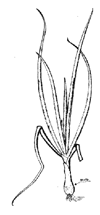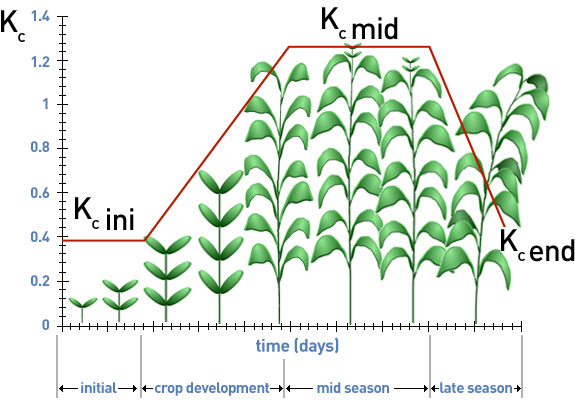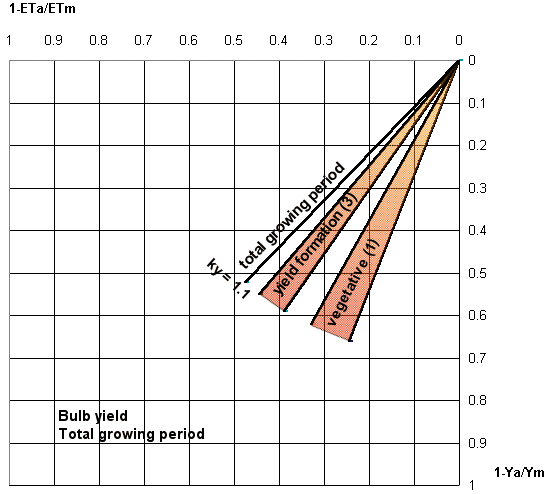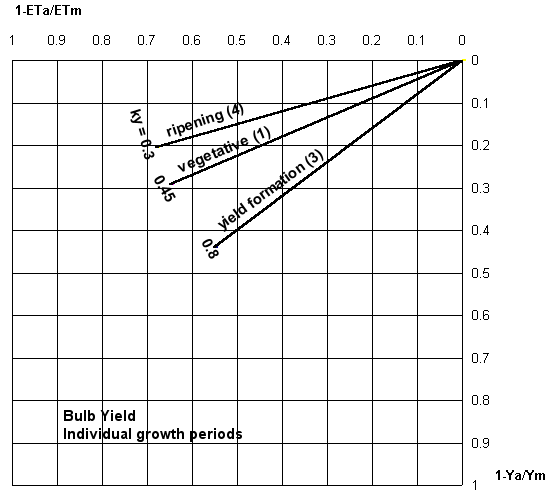1.For initiation of flowering, low temperatures (lower than 14 to 16°C) and low humidity are required.
2.Flowering is, however, little affected by daylength.

The graph below depicts the crop stages of onion, and the table summarises the main crop coefficients used for water management.

Stages of Development | Plant date | Region | |||||
|---|---|---|---|---|---|---|---|
Crop characteristic | Initial | Crop | Mid- season | Late | Total | ||
Onion – dry | |||||||
Stage length, days | 15 | 25 | 70 | 40 | 150 | April | Mediterranean |
Depletion Coefficient, p | – | – | – | – | 0.3 | ||
Root Depth, m | – | – | – | – | 0.6 | ||
Crop Coefficient, Kc | 0.7 | >> | 1.05 | 0.75 | – | ||
Yield Response Factor, Ky | 0.45 | – | 0.8 | 0.3 | 1.1 | ||
Onion – Green | |||||||
Stage length, days | 25 | 30 | 10 | 5 | 70 | April | Mediterranean |
Depletion Coefficient, p | – | – | – | – | 0.3 |
| |
Root Depth, m | – | – | – | – | 0.6 |
| |
Crop Coefficient, Kc | 0.7 | >> | 1.0 | 1.0 | – |
| |
Onion – Seed | |||||||
Stage length, days | 20 | 45 | 165 | 45 | 275 | September | Calif., Desert, USA |
Depletion Coefficient, p | – | – | – | – | 0.35 |
| |
Root Depth, m | – | – | – | – | 0.6 |
| |
Crop Coefficient, Kc | 0.7 | >> | 1.05 | 0.8 | – |
| |
For optimum yield, onion requires 350 to 550 mm water.
The crop coefficient (kc) relating reference evapotranspir ation (ETo) to water requirements (ETm) for different development stages after transplanting is,
The relationships between relative yield decrease (1 – Ya/Ym) and relative evapotranspiration deficit for the total growing period are shown in the figure below.
This figure shows the relationships between relative yield decrease (1 – Ya/Ym) and relative evapotranspiration deficit for the individual growth periods.

Onion, in common with most vegetable crops, is sensitive to water deficit.
For high yield, soil water depletion should not exceed 25 percent of available soil water.
When the soil is kept relatively wet, root growth is reduced and this favours bulb enlargement.
Irrigation should be discontinued as the crop approaches maturity to allow the tops to desiccate, and also to prevent a second flush of root growth.
The growth periods of an onion crop with a growing period of 100 to 140 days in the field are:
establishment period (from sowing to transplanting,
0) 30 to 35 days; vegetative period
(1) 25 to 30 days; yield formation
(2) bulb enlargement, 50 to 80 days;
and ripening period (4) 25 to 30 days.
The crop is most sensitive to water deficit during the yield formation period (3), particularly during the period of rapid bulb growth which occurs about 60 days after transplanting. – The crop is equally sensitive during transplantation.
For a seed crop, the flowering period is very sensitive to water deficit.
During the vegetative growth period (1) the crop appears to be relatively less sensitive to water deficits.
For high yield of good quality the crop needs a controlled and frequent supply of water throughout the total growing period; however, over-irrigation leads to reduced growth.
To achieve large bulb size and high bulb weight, water deficits, especially during the yield formation period (bulb enlargement, 3), should be avoided.
Under limited water supply small water savings can be made during the vegetative period (1) and the ripening period (4).
However, under such conditions water supply should preferably be directed toward maximizing production per hectare rather than extending the cultivated area with limited water supply.
